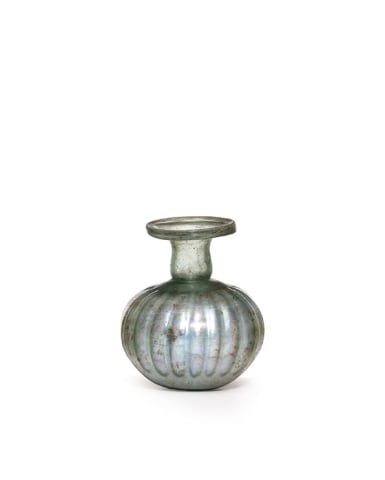Blown in transparent, blue-green glass. The compressed globular body is decorated with subtle, raised fluting, a tight constriction at neck, the flaring mouth out-turned and inward-folded. Old oval white collection label with blue border, with ‘963’ in black ink on the body. Intact, a thick pearl-like iridescence to the interior.
Provenance
Louis-Gabriel Bellon (1819-1899), St. Nicholas-les-Arras, France; collection no.963Bellon was one of the greatest French collectors of the 19th century. Making his fortune in the textile industry, he began to buy and collect archaeological pieces from the Mediterranean world. Until the end of the 1870s, he accompanied Auguste Ternick in archaeological excavations in the Arras region. It was there that he discovered the Gallo-Roman glassworks which subsequently constituted the most important part of his collection. His collection gained notoriety during the retrospective exhibition of French Art which took place at the Trocadéro in 1896, alongside those of Auguste Dutuit and the Protat printers. Today, part of the collection is kept at the Museum of National Antiquities of Saint-Germain-en-Laye, the Petit Palais in Paris, the Louvre Museum, and the Berck-sur-Mer museum.
Literature
Compare Anastassios Antonaras, Fire and Sand: Ancient Glass in the Princeton University Art Museum (Princeton, 2012), p.93, no.109
